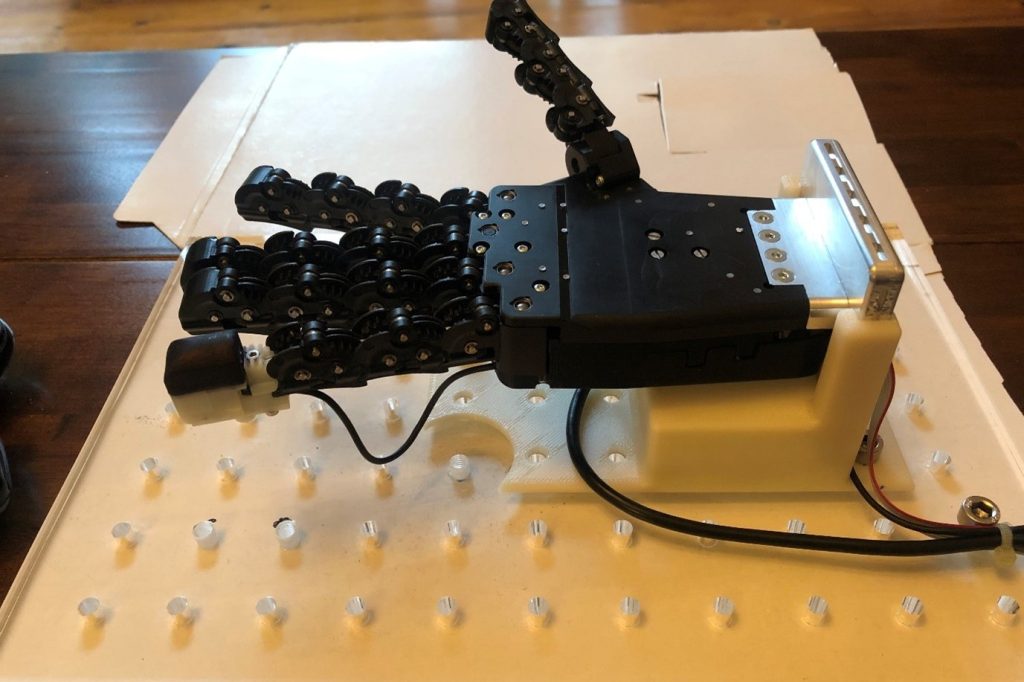Scientists at the University of Bristol have developed an artificial fingertip with the potential to allow amputees to ‘feel’ objects through prosthetic limbs.
Formed from a series of 3D printed papillae, akin to those found just beneath the surface of human skin, the team’s ‘TacTip’ device is capable of sensing shapes before relaying this data in the form of artificial nerve signals. With further R&D, the researchers say their synthetic fingertip could revolutionize the world of robotics, or help improve the grip of those with prosthetic hands around the world.
“Our work helps uncover how the complex internal structure of human skin creates our human sense of touch,” says Bristol Robotics Lab’s Professor Nathan Lepora. “This is an exciting development in the field of soft robotics – being able to 3D print tactile skin could create robots that are more dexterous or significantly improve the performance of prosthetic hands by giving them an in-built sense of touch.”
Realizing truly-tactile robotics
According to the Bristol-based scientists, advances in Artificial Intelligence (AI) mean that machines can now beat the best chess players in the world, yet robotic hands still lack the dexterity to move pieces themselves. To overcome this, the team say that the neuroscience and robotics fields are starting to “converge,” yielding artificial tactile sensory systems which can better ‘sense’ objects upon contact.
One of the keys to developing robots with a truly human-like sense of touch, lies in how such stimuli is coded in our peripheral nervous systems. In the case of human skin, it’s formed of an intricate mix of layers, microstructures and sensory receptors, which underlie many of its core functions, from protecting our internal organs to enabling sensory contact.
With this in mind, the researchers have tried to create a robotic fingertip that mimics the dermal and epidermal outer layers of human skin, by making these from a rubber-like material and soft elastomeric gel. Housed in a Stratasys-3D printed casing, the device is provided with sensory capabilities by a mesh of ridges and nodular pins seeded along its surface, much like dermal papillae.
In essence, the resulting TacTip structure can detect the deformation of skin via the lateral movement of markers on its pin tips, before relaying information collected via a series of tiny cameras. These optical markers can, at least theoretically, then slowly be tuned to match the sensory stimuli sent towards the central nervous system and brain by the human body, recreating the sensation of ‘feeling’ objects.
“Human tactile nerves transmit signals from various nerve endings called mechanoreceptors, which can signal the pressure and shape of a contact,” explains Lepora. “We found our 3D printed tactile fingertip could produce artificial nerve signals that look like recordings from real, tactile neurons.”

Putting the TacTip to the test
In order to evaluate their TacTip device, the Bristol team subjected it to three human touch experiments, designed to test its force, shape and orientation feedback capabilities. During the first of these, which saw the artificial fingertip mounted to an ABB six-axis robotic arm and compressed, it demonstrated a human-like response to pressure, albeit one that peaked in intensity slightly more quickly.
However, when used to sense the orientation of various differently-shaped gratings, the device proved less sensitive than natural skin would be. In their papers, the scientists suggest that this may be due to the fact artificial skin is thicker and less flexible than its natural counterpart, but other than a slight sensitivity loss, they maintain there was actually a “high degree of convergence” between the two.
As a result, though the team concede that the TacTip needs tweaking, they anticipate it could eventually be fitted to robotic hands, the likes of which they’re developing at their lab, to provide factory machines with the sensory perception needed to adjust their grip for picking up certain items, enabling them to automate tasks that still require a human touch.
“There are widespread uses for this kind of technology, from creating completely autonomous factories of the future to autonomous farming,” concludes Lepora. “Instead of people picking fruit or harvesting, we could have robots doing it, and in more futuristic applications, it could restore a sense of touch to prosthetic hands.”

While the concept of building robots with a human-like sense of taste or touch may sound like something straight out of a sci-fi movie, researchers continue to take concrete steps towards achieving this, often with the help of 3D printing.
As long ago as 2020, scientists at the University of Leeds and University of Edinburgh, were able to 3D print a taste-sensitive tongue. Made from artificial papillae, similar to those used by the University of Bristol team, the robotic tongue not only featured a texture akin to that of the real thing, but proved capable of detecting foods.
In terms of robotic limbs, the technology has often been deployed in this area as well, with engineers based at the University of Maryland even managing to beat Super Mario Bros with a 3D printed hand. Powered by air pressure rather than electricity, the researchers’ soft robot features just three fingers, but this hasn’t stopped it beating the game’s first level.
The researchers’ findings are detailed in their papers titled “Artificial SA-I, RA-I and RA-II/vibrotactile afferents for tactile sensing of texture” and “Artificial SA-I and RA-I afferents for tactile sensing of ridges and gratings,” which were co-authored by Nicholas Pestell, Thom Griffith and Nathan F. Lepora.
To stay up to date with the latest 3D printing news, don’t forget to subscribe to the 3D Printing Industry newsletter or follow us on Twitter or liking our page on Facebook.
For a deeper dive into additive manufacturing, you can now subscribe to our Youtube channel, featuring discussion, debriefs, and shots of 3D printing in-action.
Are you looking for a job in the additive manufacturing industry? Visit 3D Printing Jobs for a selection of roles in the industry.
Featured image shows the researchers’ 3D printed ‘TacTip’ artificial fingertip. Image via the University of Bristol.



